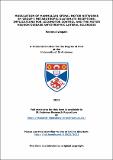Files in this item
Modulation of mammalian spinal motor networks by group I metabotropic glutamate receptors : implications for locomotor control and the motor neuron disease amyotrophic lateral sclerosis
Item metadata
| dc.contributor.advisor | Miles, Gareth Brian | |
| dc.contributor.author | Iwagaki, Noboru | |
| dc.coverage.spatial | 149 | en_US |
| dc.date.accessioned | 2012-07-26T08:19:23Z | |
| dc.date.available | 2012-07-26T08:19:23Z | |
| dc.date.issued | 2012-06-20 | |
| dc.identifier | uk.bl.ethos.555592 | |
| dc.identifier.uri | https://hdl.handle.net/10023/3023 | |
| dc.description.abstract | The present study examined the role of group I metabotropic glutamate receptors (mGluRs) in mammalian spinal motor networks and investigated the potential role of mGluRs in the fatal neurodegenerative disease amyotrophic lateral sclerosis (ALS). Group I mGluR activation was found to modulate locomotor-related activity recorded from ventral roots of in vitro mouse spinal cord preparations. Activation of group I mGluRs led to an increase in the frequency of locomotor-related bursts and a decrease in their amplitude. The cellular mechanisms underlying group I mGluR-mediated modulation were investigated using whole-cell patch-clamp recordings from spinal neurons. Recordings from motoneurons revealed a wide range of effects, some of which were expected to increase motoneuron excitability, such as membrane depolarisation and hyperpolarisation of action potential thresholds. However, the net modulatory effect of group I mGluR activation was a reduction in motoneuron excitability, likely reflecting a reduction in the density of fast inactivating Na+ currents. The activation of group I mGluRs also reduced excitatory synaptic input to motoneurons, suggesting that modulation of motoneuron properties and synaptic transmission both contribute to group I mGluR-mediated reductions in locomotor motoneuron output. Recordings from spinal interneurons revealed a smaller range of modulatory effects for group I mGluRs. The clearest effect on interneurons, membrane depolarisation, may underlie group I mGluR-mediated increases in the frequency of locomotor activity. Finally, the potential role of group I mGluRs in the pathogenesis of ALS was investigated using a mouse model of the disease. Although no major perturbations in group I mGluR-mediated modulation were demonstrated in ALS affected spinal cords, there appeared to be a difference in the intrinsic excitability of spinal interneurons between wild type and ALS affected animals. Together these data highlight group I mGluRs as important sources of neuromodulation within the spinal cord and potential targets for the treatment of ALS. | en_US |
| dc.language.iso | en | en_US |
| dc.publisher | University of St Andrews | |
| dc.subject | MGluRs | en_US |
| dc.subject | Spinal cord | en_US |
| dc.subject | Motoneurons | en_US |
| dc.subject | ALS | en_US |
| dc.subject.lcc | QP367.I8 | |
| dc.subject.lcsh | Glutamic acid--Receptors | en_US |
| dc.subject.lcsh | Motor neurons | en_US |
| dc.subject.lcsh | Locomotion--Regulation | en_US |
| dc.subject.lcsh | Amyotrophic lateral sclerosis | en_US |
| dc.title | Modulation of mammalian spinal motor networks by group I metabotropic glutamate receptors : implications for locomotor control and the motor neuron disease amyotrophic lateral sclerosis | en_US |
| dc.type | Thesis | en_US |
| dc.contributor.sponsor | Motor Neurone Disease Scotland | en_US |
| dc.type.qualificationlevel | Doctoral | en_US |
| dc.type.qualificationname | PhD Doctor of Philosophy | en_US |
| dc.publisher.institution | The University of St Andrews | en_US |
This item appears in the following Collection(s)
Items in the St Andrews Research Repository are protected by copyright, with all rights reserved, unless otherwise indicated.

